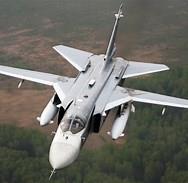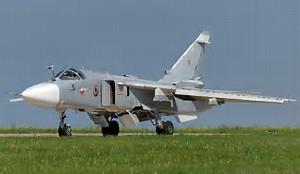S'sonic
Stealth
Menu
A free template by Lucknowwebs.com for WYSIWYG WebBuilder 8
Powered by Sispro1-S
Nigel G Wilcox
Paragon Of Space Publication
© Copyright Reserved - United Kingdom
Ideal Screen Composition 1024 x 768
SITEMAP
PSEUDO SCIENCE
SCIENCE RESEARCH
ABOUT
Desk
Supersonic
Stealth
Study
Menu
MAIN INDEX
Fastest Air Planes
Space
Transport
Menu
Sukhoi-Su-24-Fencer
Bell X-2 Starbuster
F-35 Lightning II
The Sukhoi Su-24 is a supersonic, all-weather attack aircraft developed in the Soviet Union.
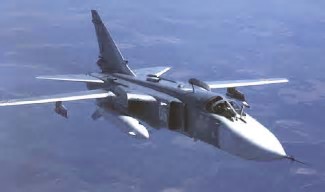

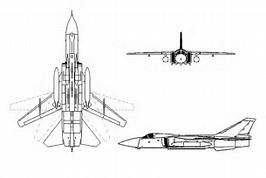
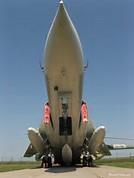
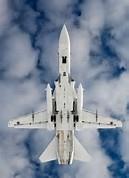
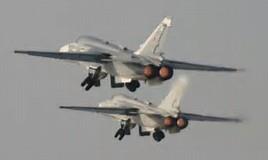
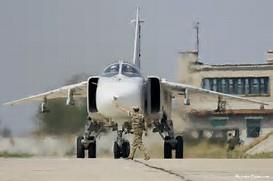

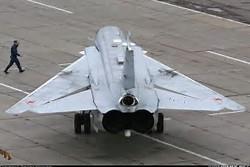
General characteristics
Crew: 2 (pilot and weapons systems operator)
Length: 22.53 m (73 ft 11 in)
Wingspan:
With wings spread: 17.64 m (57 ft 10 in)
With wings swept: 10.37 m (34 ft)
Height: 6.19 m (20 ft 4 in)
Wing area: 55.2 m² (594 sq ft)
Empty weight: 22,300 kg (49,165 lb)
Loaded weight: 38,040 kg (83,865 lb)
Max. takeoff weight: 43,755 kg (96,505 lb)
Fuel capacity: 11,100 kg (24,470 lb)
Powerplant: 2 × Lyulka AL-21F-3A turbojets Dry thrust: 75 kN (16,860 lbf) each
Thrust with afterburner: 109.8 kN (24,675 lbf) each
Performance
Maximum speed:
At sea level: Mach 1.06 (1,315 km/h; 815 mph)
At high altitude: Mach 1.6 (1,654 km/h; 1,030 mph)
Combat radius: 615 km in a low-flying (lo-lo-lo) attack mission with 3,000 kg (6,615 lb) of ordnance and external tanks
Ferry range: 2,775 km (1,725 mi; 1,500 nmi)
Service ceiling: 11,000 m (36,090 ft)
Rate of climb: 150 m/s (29,530 ft/min)
Wing loading: 651 kg/m² (133 lb/ft²)
Thrust/weight: 0.6
Maximum g-load: 6 g
Armament
Guns: 1 × internal 23 mm Gryazev-Shipunov GSh-6-23M rotary cannon with 500 rounds
Hardpoints: 9 hardpoints with a capacity of up to 8,000 kg (17,635 lb) and provisions to carry combinations of: Rockets:
S-5
S-8
S-13
S-24B
S-25-OFM/LD
Missiles:
Air-to-air missiles: 4 × R-60MK
4 × R-73E
Air-to-surface missiles: 4 × Kh-23M
4 × Kh-25ML
Kh-59ME
Kh-29L/T/D
Anti-ship missiles: Kh-31A
Anti-radiation missiles: 2 × Kh-28
2 × Kh-58E
Kh-25MP
2 × Kh-31P
Kh-27PS
Bombs:
KAB-500KR TV-guided bomb
KAB-500L laser-guided bomb
KAB-500OD guided bomb
KAB-500S-E satellite-guided bomb
KAB-1500KR TV-guided bomb
KAB-1500L laser-guided bomb
ODAB-500PM bomb
RBK-250 cluster bomb
RBK-500 cluster bomb
2 × BETAB-500 bomb
Avionics
SVP-24 targeting system
Role: All-weather attack aircraft
National origin: Soviet Union / Russia
Manufacturer: Sukhoi
Designer: Ye. S. Felsner (from 1985)
L.A. Logvinov
First flight: T-6: 2 July 1967
T-6-2I: 17 January 1970
Introduction: 1974
Status: In service
Primary users: Russian Air Force
Ukrainian Air Force
Kazakh Air Force
Islamic Republic of Iran Air Force
Produced: 1967-1993
Number built: Approximately 1,400
Unit cost: US$24-25 million in 1997
The Sukhoi Su-24 "Fencer" was the Soviet answer to the American General Dynamics F-111 Aardvark. The Soviet design was no doubt inspired by the impressive and powerful "swing-wing" American design and attempted to follow suit with an equally capable mount worthy of her Soviet airmen. After some 35+ years of active service, the end is near for the impressive Fencer, gradually outdated in many facets of her makeup. She was debuted in anger during the Soviet war in Afghanistan and saw combat in the Persian Gulf War of 1991, actions against Chechen rebels of the Chechen Republic and thought to have participated in recent operations over South Ossetia in the 2008 "limited war" with Georgia. In all, approximately 1,400 Su-24s have been produced by Sukhoi OKB in three distinct operational variants and delivered to a handful of foreign operators.
The Sukhoi design bureau had its origins in wartime 1939 and became something of a household name throughout World War 2. In the post-war world - 1959 to be exact - the firm delivered their first Su-7 "Fitter" jet-powered fighters to the ranks of the Frontal Aviation (Frontovaya Aviahtsiya), this being the tactical component of the Soviet Air Force. The initial Su-7 was a dedicated tactical air superiority fighter design while the follow-up Su-7B was introduced as a ground attack version in 1961. One of the pre-requisites of the Soviet Air Force's acceptance of the Su-7 into service was that the firm also develop a suitable all-weather strike variant to be tied with a new navigation/attack system known as the "Puma".
Sukhoi set about on some preliminary work in trying to utilize the existing Su-7 airframe for the all-weather strike task. It was quickly realized that the Su-7's airframe was ill-suited for the amount of additional avionics and equipment that would be required in making the Fitter a right "fit" for the role. As a result, other designs solutions were entertained.
While introduction of the Fitter did well to strengthen the Soviet Air Force's aging fleet of fighters, there was no true solution in beefing up her long-range bomber arm. In the inventory remained the aged Ilyushin IL-28, introduced in 1950 and categorized as a medium bomber. The Yakovlev Yak-28 "Bewer"/"Firebar"/"Maestro" series was unveiled in 1958 and first flew in 1960, intended to become the answer to the growing Soviet question. However, once in service, the Yak-28 was quickly noted for its disappointingly short operational ranges and small payload capabilities - two qualities critical to a successful bomber design in the Cold War. Additionally, weapons firing and general munitions delivery accuracy left something to be desired by the Soviet Air Force. Regardless, some 1,180 such systems were placed into circulation and the type was developed to fulfill a variety of battlefield functions.
Production was selected to begin at Factory No. 153 at Novosibirsk. The first production Su-24 went airborne on December 31st, 1971, with test pilot Vladimir Vylomov at the controls. Early Su-24s ("Fencer-A") were fielded in small numbers and this limited to trials units, leaving the Fencer-Bs as the true initial production face of the line. Fencer-C came online some time later and sported improved avionics. Though differences between the three were many, they were more-or-less minor enough to not warrant new designations from Sukhoi. Only NATO required the varying "Fencer" designations for their own nomenclature.
Her rush to delivery produced a few teething problems from the start, forcing several - though multiplying - modifications to be enacted (both to current and former aircraft) based on operational feedback from crews. Such changes included the enlarging of an internal fuel tank to increase the aircrafts range. Another included am aerodynamic revision of key rear fuselage surfaces in an effort to reduce airframe drag. The brake chute was relocated and a ram-air inlet was installed at the base of the tail fin. While early Su-24s sported variable intake ramps within their intake openings, this was later dropped to improve maintenance requirements and save on weight. The removal of these devices dropped the overall speed of the Su-24 from Mach 2.18 to Mach 1.35 - as devastating as this may have appeared, the expected low-level operations of the Su-24 suffered little in the move. The countermeasure capabilities of early Su-24s were progressively updated to include improved radar warning and missile launch warning coupled with integral onboard jamming equipment.
The Su-24 would not be formally accepted into service until February 6th, 1975. Her slab-sided fuselage eventually earned her the nickname of "Suitcase" from her crews. The West would not find out about the Su-24 until perhaps 1974 to which the incorrect designation of "Su-19" was assigned. Interestingly, this mistake would not be officially corrected until 1981. In true NATO fashion, the codename of "Fencer" was applied to the Su-24 - "F" being for "Fighter" ("B" was reserved for Bombers as in the "Brewer", "Bear", "Bison" etc...). It was not until the Soviet Air Force began arriving at East German air fields in 1979 did many of the fantastic Western estimates about the new Soviet aircraft finally dissolve.
Supersonic, all-weather attack aircraft developed in the Soviet Union. The aircraft has a variable-sweep wing, twin-engines and a side-by-side seating arrangement for its two crew. It was the first of the USSR's aircraft to carry an integrated digital navigation/attack system. It remains in service with the Russian Air Force, Ukrainian Air Force, and various air forces to which it was exported.
Maximum speed: 1,315 km/h (817.10 mph) Maiden flight: 02 Jul 1967 Length: 73.92 ft Passengers: 2 Introduced: 1974 Manufacturer: Sukhoi



